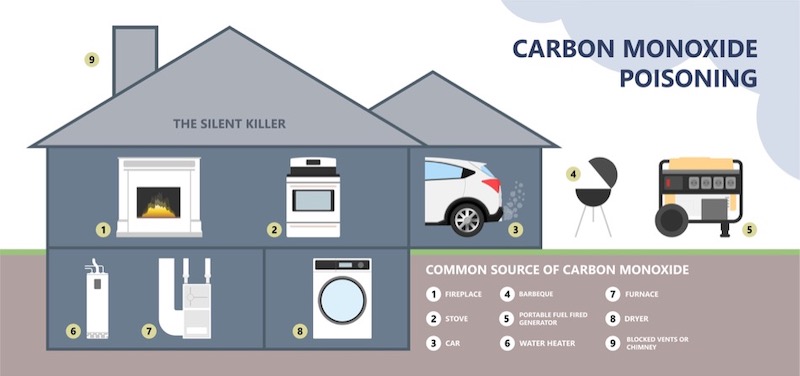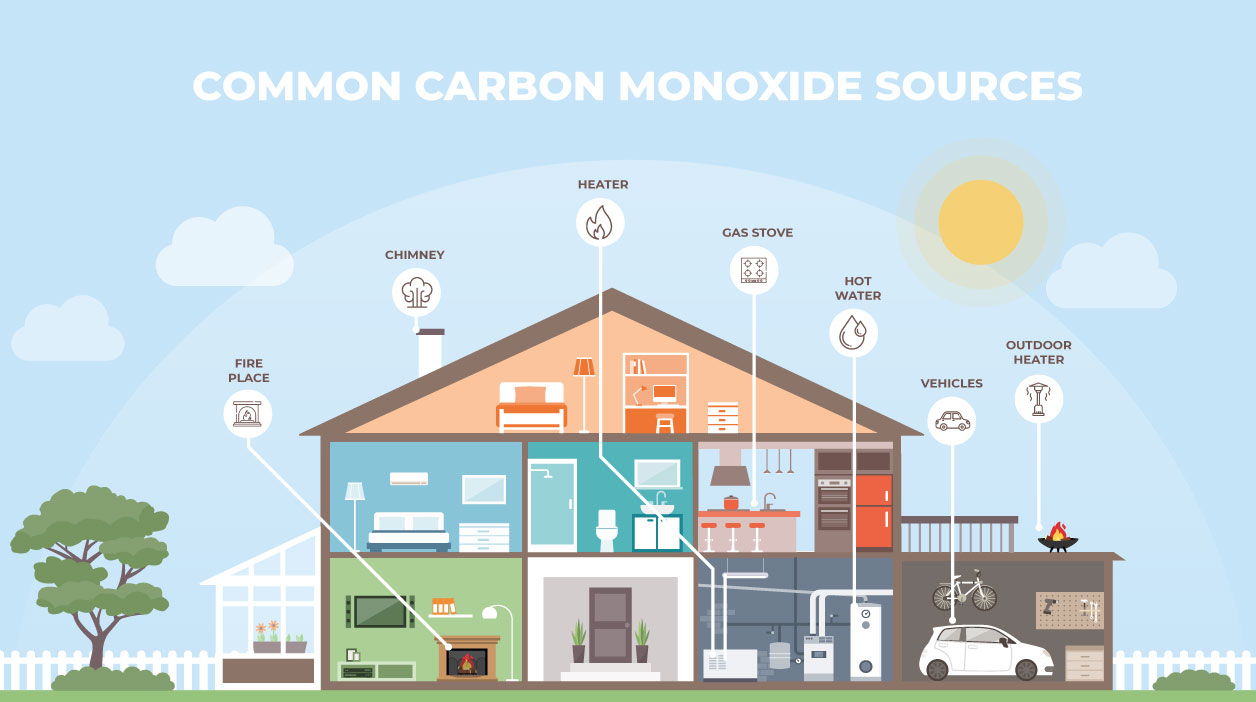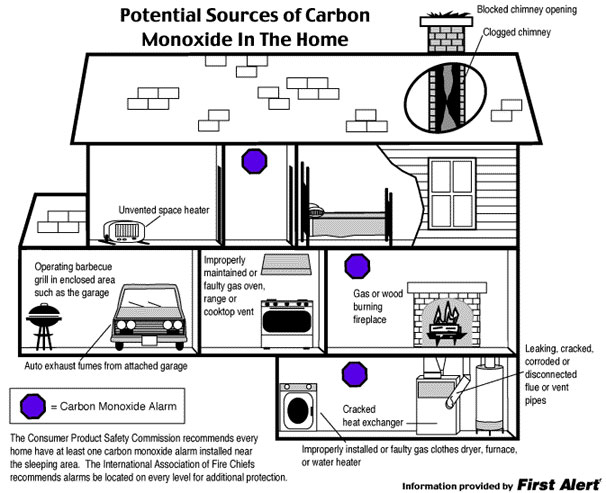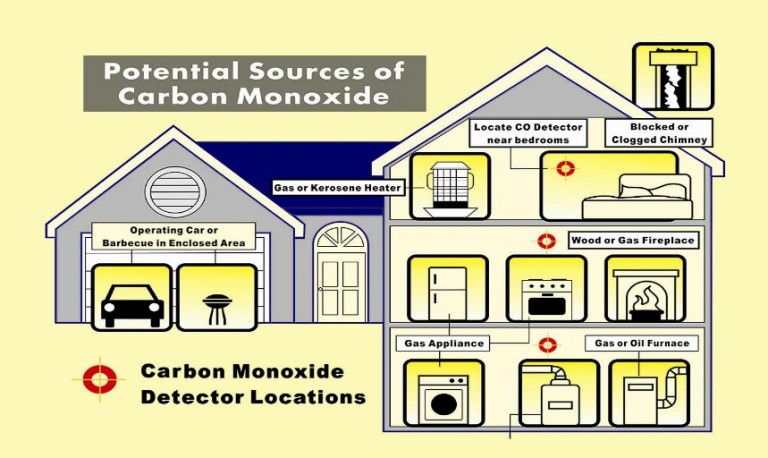What Gives Off Carbon Monoxide In A Home

One of the most frightening, yet preventable, dangers in a home is carbon monoxide (CO) poisoning. CO is an odorless, colorless gas that can build up to dangerous levels, causing serious illness or even death. Many homeowners don't realize the potential sources of CO in their homes and how to troubleshoot potential problems. This guide will walk you through common causes of CO buildup and provide a systematic approach to diagnosis and safe, simple fixes. Remember, your safety is paramount. If you suspect CO poisoning, evacuate immediately and call 911.
Understanding Carbon Monoxide and its Sources
Carbon monoxide is produced by the incomplete combustion of fuels. This means that when appliances that burn fuel don't have enough oxygen to burn completely, they produce CO instead of carbon dioxide (CO2). The most common culprits are:
- Fuel-burning appliances: Furnaces, water heaters, stoves, ovens, dryers, fireplaces, and space heaters.
- Vehicles: Cars, trucks, and generators running in attached garages or near windows/doors.
- Blocked or damaged vents and chimneys: Preventing proper exhaust of combustion byproducts.
The key to preventing CO poisoning is ensuring these appliances are working correctly and are properly vented.
Step 1: Recognizing the Warning Signs
Before we delve into troubleshooting, it's crucial to recognize the symptoms of CO poisoning. These can be easily mistaken for the flu, so pay close attention, especially if multiple people in your household experience similar symptoms:
- Headache
- Dizziness
- Weakness
- Nausea
- Vomiting
- Chest pain
- Confusion
- Loss of consciousness
If you or anyone in your home experiences these symptoms, evacuate immediately and call 911.
Step 2: Initial Assessment - Checking Your Carbon Monoxide Detectors
The first line of defense against CO poisoning is a working CO detector. Make sure you have at least one on each level of your home, especially near sleeping areas.
Diagnosis:
- Check the batteries: Ensure the detector has fresh batteries. Most detectors will chirp when the batteries are low. Replace them immediately.
- Test the detector: Press the test button. The detector should sound a loud alarm. If it doesn't, replace the detector immediately.
- Check the expiration date: CO detectors have a limited lifespan, typically 5-10 years. Check the expiration date on the back of the detector. If it's expired, replace it.
- Is the alarm chirping intermittently without any other symptoms? This could indicate a low battery or a malfunction. Try replacing the batteries first. If the chirping continues, replace the detector.
DIY Fixes:
- Replace batteries.
- Replace expired or malfunctioning detectors.
When to call a professional: If your CO detector is alarming and you are experiencing symptoms of CO poisoning, evacuate immediately and call 911. Do not attempt to diagnose the source of the CO leak yourself. If your CO detector is alarming and no one is experiencing symptoms, ventilate the house by opening windows and doors, and then call your local fire department or a qualified HVAC technician to investigate.
Step 3: Inspecting Fuel-Burning Appliances
Now, let's examine the potential sources of CO – your fuel-burning appliances. Start with the most commonly used appliances like your furnace and water heater.
A. Furnace
Diagnosis:
- Visual Inspection: Look for signs of rust, soot, or damage around the furnace and its vent pipes.
- Check the Flame: Observe the burner flame through the view port (if available). A healthy flame should be blue with a slight yellow tip. A yellow, orange, or flickering flame indicates incomplete combustion.
- Smell for Unusual Odors: A strong, unusual odor near the furnace could indicate a problem.
- Check the Air Filter: A dirty air filter restricts airflow, which can lead to incomplete combustion.
DIY Fixes:
- Replace the Air Filter: A clean air filter is crucial for proper furnace operation. Replace it every 1-3 months, or more often if you have pets or allergies.
- Clear Debris Around the Furnace: Ensure the area around the furnace is clear of obstructions that could restrict airflow.
When to call a professional: If you see signs of rust, soot, or damage, or if the flame is yellow, orange, or flickering, do not attempt to repair the furnace yourself. Contact a qualified HVAC technician for inspection and repair. A faulty furnace can be extremely dangerous.
B. Water Heater
Diagnosis:
- Visual Inspection: Look for rust, soot, or water leaks around the water heater.
- Check the Flame: Similar to the furnace, a healthy water heater flame should be blue with a slight yellow tip.
- Smell for Unusual Odors: A sulfurous or rotten egg smell could indicate a gas leak (natural gas is usually odorless but has a sulfur-like odor added for safety).
- Check the Vent Pipe: Ensure the vent pipe is securely connected and free of obstructions.
DIY Fixes:
- Clear Debris Around the Water Heater: Ensure the area around the water heater is clear of obstructions.
When to call a professional: If you see signs of rust, soot, or water leaks, if the flame is yellow, orange, or flickering, or if you smell a sulfurous odor, do not attempt to repair the water heater yourself. Contact a qualified plumber or HVAC technician for inspection and repair.
C. Fireplace
Diagnosis:
- Check the Chimney: Look for cracks, damage, or obstructions in the chimney.
- Ensure Proper Ventilation: Open the damper fully before lighting a fire.
- Inspect for Soot Buildup: Excessive soot buildup can restrict airflow and lead to CO buildup.
DIY Fixes:
- Ensure the Damper is Open: Before lighting a fire, always double-check that the damper is fully open.
When to call a professional: If you see cracks, damage, or obstructions in the chimney, or if you suspect excessive soot buildup, contact a qualified chimney sweep for inspection and cleaning. A blocked or damaged chimney can be extremely dangerous.
D. Stoves and Ovens
Diagnosis:
- Check the Flame: Gas stoves and ovens should have blue flames. Yellow or orange flames indicate incomplete combustion.
- Inspect Burner Ports: Ensure the burner ports are clean and free of debris.
- Smell for Gas Leaks: Be alert for any unusual gas odors.
DIY Fixes:
- Clean Burner Ports: Use a wire brush or pin to clear any debris from the burner ports.
When to call a professional: If the flames are consistently yellow or orange after cleaning the burner ports, or if you smell a gas leak, contact a qualified appliance repair technician. Do not attempt to repair a gas stove or oven yourself if you suspect a gas leak.
E. Portable Generators
Portable generators are a significant CO risk, especially when used improperly. Never run a generator inside your home, garage, or any enclosed space.
Diagnosis:
- Location: Ensure the generator is located at least 20 feet away from your home, windows, and doors.
- Exhaust Direction: Position the generator so that the exhaust fumes are directed away from your home.
- Carbon Monoxide Detectors: Always have working CO detectors in your home when using a generator, even if it's outside.
DIY Fixes:
- Relocate the Generator: If the generator is too close to your home, move it further away.
- Ensure Proper Ventilation: Never operate a generator in an enclosed space.
When to call a professional: If you suspect that a generator has caused CO poisoning, evacuate immediately and call 911. Do not attempt to move the generator until first responders have arrived and deemed it safe to do so.
Step 4: Checking Vents and Chimneys
Proper ventilation is crucial for safely removing combustion byproducts from your home. Blocked or damaged vents and chimneys can lead to CO buildup.
Diagnosis:
- Visual Inspection: Check vents and chimneys for obstructions, such as bird nests, leaves, or debris.
- Look for Damage: Inspect for cracks, rust, or other signs of damage.
DIY Fixes:
- Clear Obstructions: Remove any visible obstructions from vents and chimneys. Use a long pole or brush to reach higher areas.
When to call a professional: If you find cracks, damage, or significant obstructions that you cannot safely remove, contact a qualified chimney sweep or HVAC technician for inspection and repair. Never attempt to climb onto your roof without proper safety equipment and training.
Step 5: Vehicle Exhaust
Running a car or other vehicle in an attached garage, even for a short time, can quickly lead to dangerous CO levels in your home.
Diagnosis:
- Garage Door: Never run a vehicle in an attached garage with the garage door closed.
- Ventilation: Even with the garage door open, ensure adequate ventilation when running a vehicle.
DIY Fixes:
- Open Garage Door: Always open the garage door fully when running a vehicle.
- Limit Running Time: Minimize the amount of time you run a vehicle in the garage.
When to call a professional: If you suspect that vehicle exhaust has caused CO poisoning, evacuate immediately and call 911. Ensure the vehicle is turned off and removed from the garage after the house is properly ventilated.
Preventative Measures
Beyond troubleshooting, taking preventative measures is the best way to protect your family from CO poisoning:
- Regular Maintenance: Schedule regular maintenance for your fuel-burning appliances by a qualified technician.
- Install CO Detectors: Install CO detectors on every level of your home, especially near sleeping areas.
- Educate Your Family: Teach your family members about the dangers of CO poisoning and the symptoms to watch for.
- Never Use Charcoal Grills Indoors: Charcoal grills produce high levels of CO and should only be used outdoors.
Conclusion
Carbon monoxide is a silent killer, but with knowledge and vigilance, you can protect your home and family. By following this guide and taking preventative measures, you can minimize the risk of CO poisoning and ensure a safe and healthy home. Remember, when in doubt, always call a professional. Your safety and the safety of your family are worth it.









